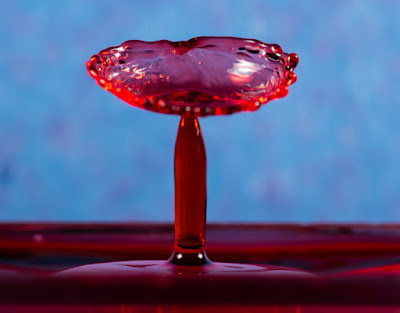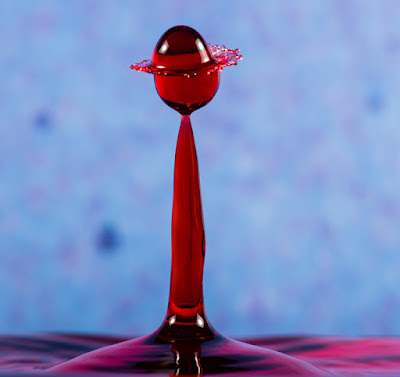The Pluto trigger is an amazing tool for beginning to learn high speed photography. With the Pluto valve, I'm learning to make water drop sculptures and its great fun. The trick is to get the flash and drop delay timing right. The Trigger and valve are controlled by the Pluto app (for Pluto for Android and Pluto for iPhone).
After a lot of shots and frustration, I finally realized that guessing would result in accumulating a zillion "null" photos. So I tried making a video of the sequence: release drop, drop response and camera flash. I needed to view both the audio track (to see the time of the Trigger "beep", identify the solenoid click of the valve releasing a drop and the frame associated with the flash. To view the video and audio, I use a free app, Videopad Video Editor. Here is an example:
Pluto Trigger and Valve setup: Center on the ring stand is the Pluto Valve connected to the Pluto Trigger (left of camera). Under is a small plastic box for receiving the drop (sitting on top of a paper towel). Behind the bath is a piece of construction paper for background. To either side is a Meike 320 flash (controlled by a Yongnu 622 flash trigger). In front is a Nikon D5300 with a Tamron 60mm macro lens connected to the Pluto Trigger (to the left of the camera)
VIdeo of the drop and photo sequence. The Pluto Trigger make a beep when it starts a sequence, the Valve makes a click (the solenoid either opening or closing the water tube) and the flash make a light. The sound track provides the time of each event (with a 33 msec error due to 60 frames/sec video). I measure the time of trigger initiation, drop 1, drop 2 and camera trigger from the sound track as shown below. The time of the flash is measured by finding the frame that that is over exposed due to the flash.
Here are screenshots illustrating the association between the audio and video tracks.
A screenshot of my Nexus android phone running the Pluto app, droplet option. The vertical line is a needle suspended by a thread from the outlet of the Pluto Valve. I use this for focus.
Screenshot of Videopad, with a video player in the top, a frame track below and an audio track below. The red cursor is used to identify each event. Above the "Play arrow to the left of the red cursor is the time of the event. Here the cursor is located over the "beep" and the indicated time is 01:51.557
Cursor over drop 1 release
Cursor placed over the solenoid click for drop 2: time is 01:51.873
Cursor placed over the max height of the Worthington jet (looks like a chess pawn): time is 01:52.136
The cursor is move until the player reveals the flash event (over exposed and easy to identify). Time is 01:52.159
Using the time of the max amplitude of the Worthington jet, I can dial in the delay for drop 2 in order to produce a collision. The following were made using the same parameters, indicating the variability in response.











No comments:
Post a Comment